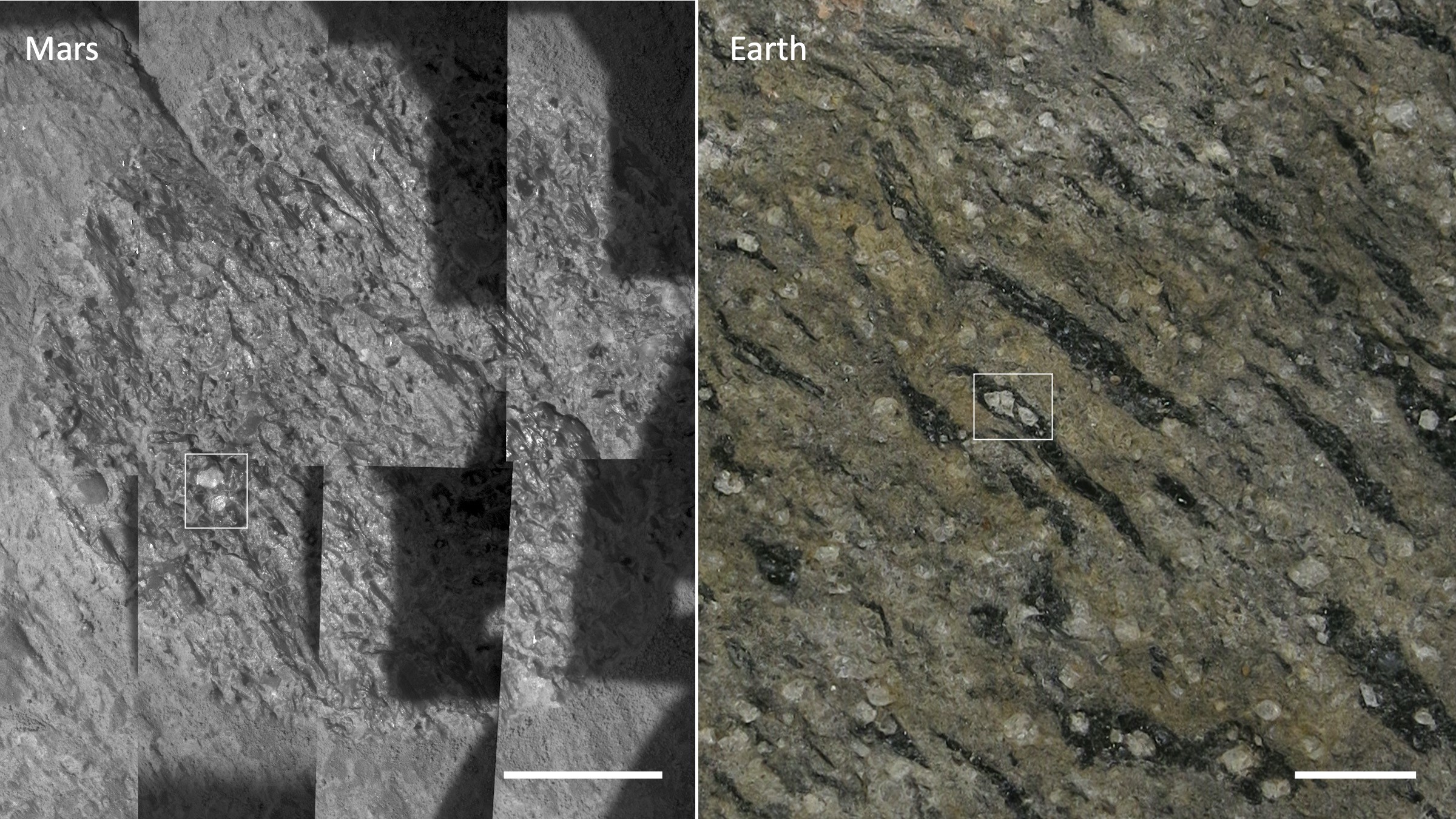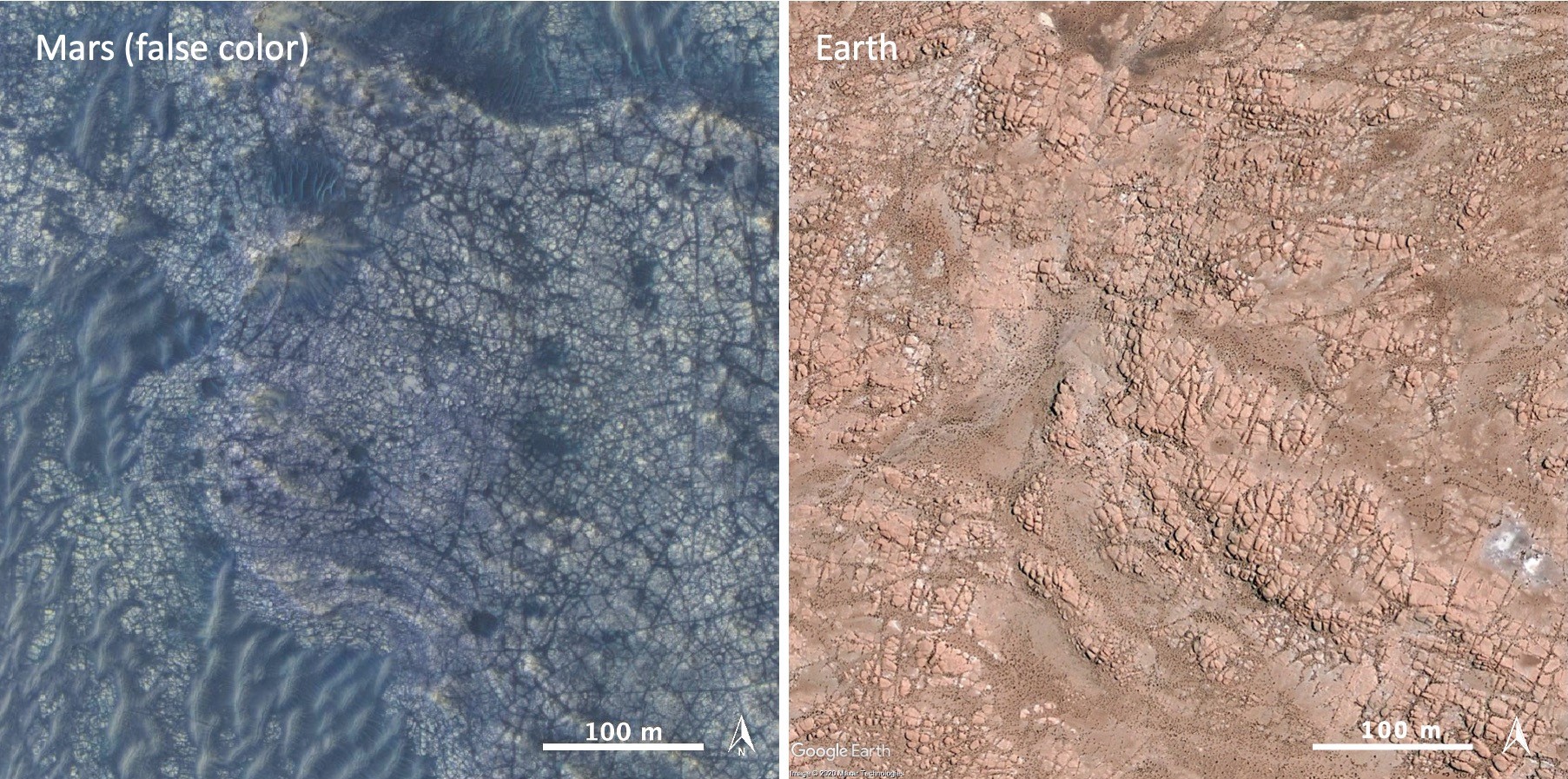Enigmatic rocks on Mars show evidence of a violent origin

Outcrop of olivine-rich bedrock in Gusev crater observed with Spirit’s Panoramic Camera (Pancam) in 2005. Image by NASA/JPL/Cornell/ASU
Determining the history of Mars, how it formed and evolved over time, has been a goal of both orbiter and rover missions to the Red Planet for decades.
Analyzing data from several of these Mars missions, a team of researchers led by Steve Ruff of Arizona State University’s School of Earth and Space Exploration has determined that enigmatic olivine-rich bedrock in Gusev crater and in and around Jezero crater may be a type of rock called “ignimbrite,” which is both igneous and sedimentary and forms as the result of cataclysmic explosive eruptions from immense volcanic calderas.
If the team is correct, this may lead to a better understanding of olivine-rich bedrock in other places on Mars and may also indicate a style of volcanism more common in Mars’ early history. The results of their study have been recently published in Icarus.
“There are lots of ideas for the origin of olivine-rich bedrock that covers large portions of a region called Nili Fossae, which includes Jezero crater,” Ruff said. “It’s a debate that’s been going on for nearly 20 years.”
Exposures of bedrock rich in olivine and also carbonate link Gusev crater, explored 16 years ago by NASA’s Spirit rover, and the Nili Fossae region where the Mars 2020 Perseverance rover is currently exploring in Jezero crater. Both locations have the highest abundance of olivine yet identified on Mars. The similarities in composition and morphology of the widely separated olivine-rich rocks had not been investigated previously. Now it appears that they formed in a similar way.
Olivine is a common silicate mineral that comes from magma generated in the mantle of Mars (this same process occurs on Earth as well). So some kind of volcanic process is a reasonable explanation for the origin of the olivine-rich rocks on Mars. But scenarios ranging from lava flows to a giant impact dredging up olivine from the mantle had been proposed previously.
Ruff and the team aimed to test a leading hypothesis involving ash gently deposited from volcanic plumes. But their observations revealed a much more violent history.
In particular, Ruff examined mosaics of images from the Mars rover Spirit’s Microscopic Imager (which is like a geologist's hand lens) and noticed rocks with an unusual texture. Ruff consulted an online library with images of rocks on Earth and came across some volcanic rocks with textures that looked remarkably similar to those in the mosaics from Mars.
“That was a eureka moment,” says Ruff. “I was seeing the same kind of textures in the rocks of Gusev crater as those in a very specific kind of volcanic rock found here on Earth.”
The left image is a mosaic from Spirit’s Microscopic Imager showing dark-toned diagonally oriented features with flame-like shapes that are possible flattened pumice fragments known as fiamme, which include light-toned crystals (white rectangle), both resembling those in the example of ignimbrite from Earth on the right. The dark angular portions are shadows from rover hardware. The white scale bar represents 1 cm in both images. Images by NASA/JPL/USGS and Scripps Institution of Oceanography
The images were from a type of rock called “ignimbrite,” which essentially is both igneous and sedimentary at once. Ignimbrites form as the result of flows of pyroclastic ash, pumice and blocks from the largest volcanic explosions known on Earth.
“Imagine a ground-hugging cloud of hot gases and nearly molten ash and pumice flowing through the landscape for dozens of miles and piling up in layers up to hundreds of feet thick in just a few days,” Ruff said.
Following their emplacement, ignimbrite deposits slowly cool over months or years. This leads to intricate networks of fractures known as cooling joints, which form as the thick piles of ash and pumice contract. Ruff recognized notably similar fracture patterns in the olivine-rich bedrock deposits on Mars, adding to the evidence for an ignimbrite origin.
On Earth, ignimbrites are found in places like Yellowstone National Park in the Western U.S. The yellow-hued rocks are ignimbrites from a huge volcanic caldera that formed during a period beginning about 2.1 million years ago and is now filled in.
“No one had previously suggested ignimbrites as an explanation for olivine-rich bedrock on Mars,” Ruff said. “And it’s possible that this is the kind of rock that the Perseverance rover has been driving around on and sampling for the past year.”
Mars has the biggest volcano in the solar system and lava flows that cover huge swaths of the planet, so volcanic rocks are a given. But only a few places had been suggested to contain ignimbrites, and until now only tentatively.
The false-color image on the left shows olivine-rich deposits in the Nili Fossae region compared with welded ignimbrite deposits on Earth (true color). The fractures in the Earth example are cooling joints, which closely resemble those in the Mars example. Images by HiRISE/Google Earth
With this team’s new findings, it is possible that ignimbrites occur in both Jezero and Gusev craters. Other locations with olivine-rich bedrock also are candidate ignimbrite deposits, and all of them appear to have formed early in Mars history, during the first billion years or so.
“The olivine-rich composition is unusual for most ignimbrites on Earth, but there is evidence for this composition in the oldest ones. Now with the strong evidence for ancient olivine-rich ignimbrites on Mars, maybe this points to a style of volcanism, cataclysmic explosive eruptions of olivine-rich magma, that happens in the early geologic evolution of a planet,” Ruff said. “The answer in the case of Mars may come from rock samples collected by Perseverance and returned to Earth by future missions.”
Additional authors of this study are Victoria Hamilton of the Southwest Research Institute, Deanne Rogers of Stony Brook University, Christopher Edwards of Northern Arizona University and Briony Horgan of Purdue University.
More Science and technology

ASU to host 2 new 51 Pegasi b Fellows, cementing leadership in exoplanet research
Arizona State University continues its rapid rise in planetary astronomy, welcoming two new 51 Pegasi b Fellows to its exoplanet…

ASU students win big at homeland security design challenge
By Cynthia GerberArizona State University students took home five prizes — including two first-place victories — from this year’s…

Swarm science: Oral bacteria move in waves to spread and survive
Swarming behaviors appear everywhere in nature — from schools of fish darting in synchrony to locusts sweeping across landscapes…



